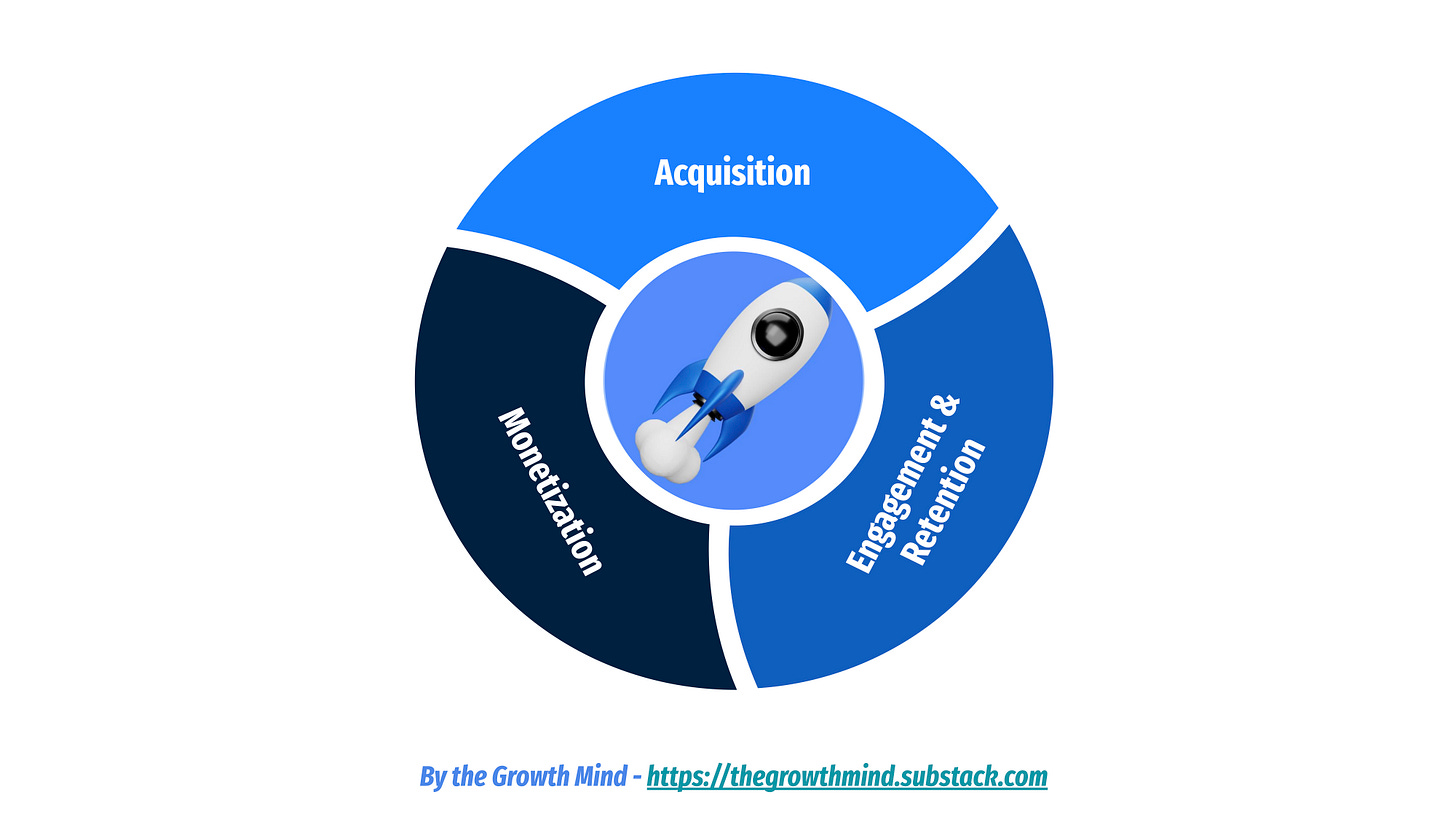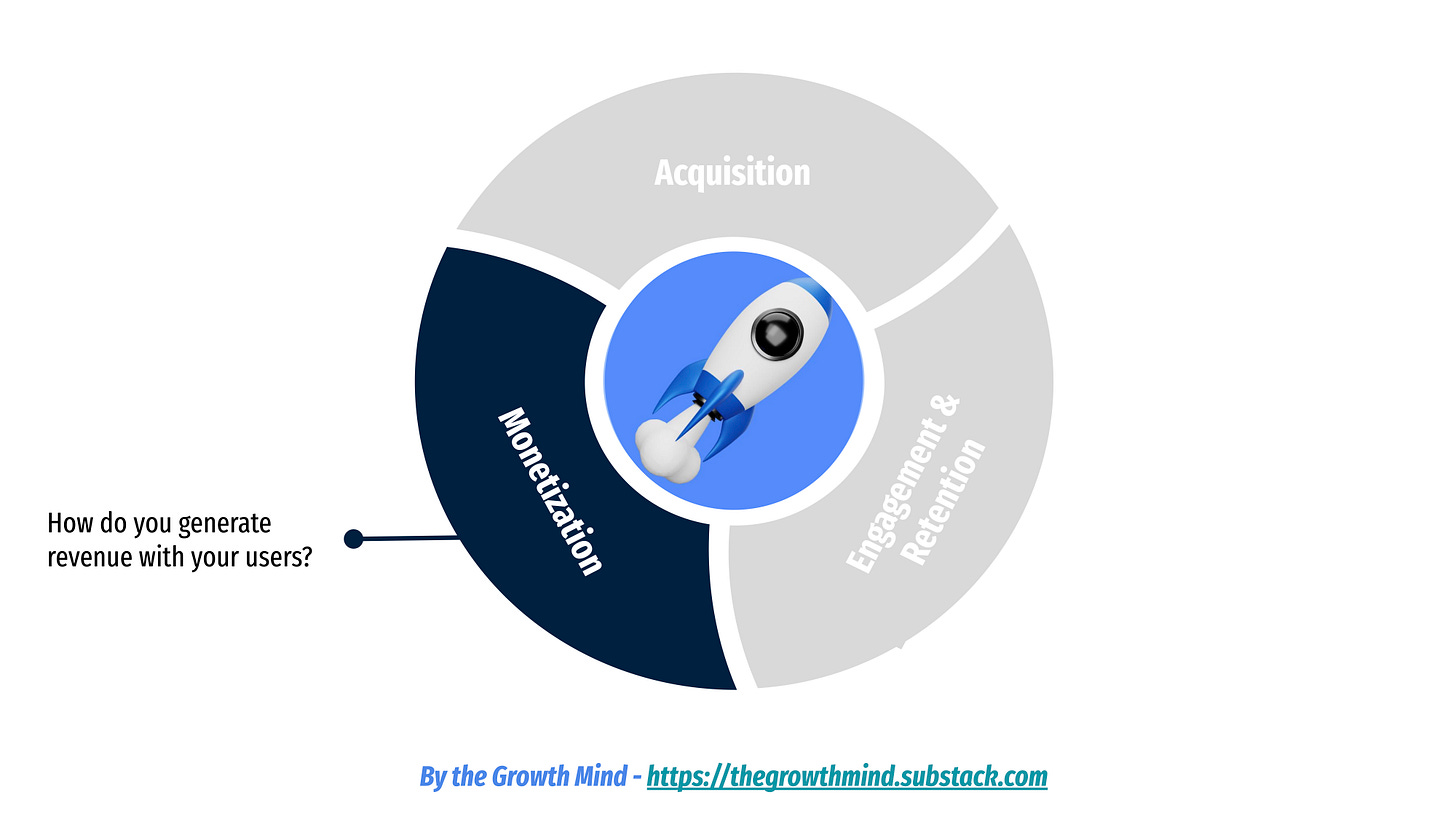Monetization - Growth Metrics Series (3/3)
Increase revenue by looking at the right monetization indicators
👋 Hi there, it’s Pierre-Jean. Welcome to this new edition of The Growth Mind!
This post is the last one of the “Growth Metrics” series, divided into 3 posts sent over 3 days:
Monetization Metrics
⏱️ Reading time = 3 minutes
If you missed the 2 previous posts, here is a reminder of the 3 growth stages we use to monitor Growth
🎯 Acquisition: How do you make users sign-up for your product? It’s all about feeding your top of the funnel and converting visitors into leads.
♻️ Engagement and retention: Do people use your product deeply, over time? Here we want to convert leads into active users who strongly engage with our product over time.
💸 Monetization: How do you generate revenue with your users? Monetizing well leads to generating revenue. We want to look at how we perform at making revenue out of our existing users.
For each stage, it’s crucial to monitor the right metrics to see where you perform and where you can look for improvements.
Improving each metric individually can lead to a strong impact on your revenue.
Let’s finish the “Growth Metrics” series with Monetization metrics 💸
Share of monetized users: The percentage of your user base which is monetized. Improving this share of monetized users is a great way to directly improve revenue. Some products are designed to monetize all their users. But many products offer some free features or trials or even don’t monetize some countries at first.
Free to Paid Conversion Rate: The percentage of users who upgrade from a free to a paid plan. This is a metric essential if you’re running a subscription business, like a SaaS or mobile app.
ARPU: Average revenue per user. To calculate it, you need to divide your total revenue by your number of users.
ARPPU: Average Revenue per paying user. The only difference with ARPU is that, instead of dividing your revenue by your total number of users, you divide it by your number of paying users only.
Gross Revenue: The total revenue generated by sales, before any deductions.
Net Revenue: Revenue after all costs and deductions have been taken out. It can include any cost linked to the delivery of the product, like a commission taken by a distribution partner, discounts, or allowances.
GMV: Gross merchandise value represents the total volumes of sales happening on a platform. This metric is monitored by marketplaces or e-commerce stores, to evaluate the growth of transaction volumes.For instance, if a marketplace sells a service for $10 and takes a 20% commission, its GMV would be $10, but its revenue would be $2.
Lifetime Value (LTV): The total revenue you make from one customer during the lifetime of your relationship. LTV can be increased by improving retention, but also by doing upsell or selling higher priced tickets.
MRR/ARR (Monthly/Annual Recurring Revenue): If you’re running a subscription-based product, that’s probably the most financial metric to follow in Growth. This is one of the favorite indicators for SaaS.
Revenue from new customers VS existing customers: Selling to existing customers is easier and cheaper than selling to new ones. But you should not be too dependent on existing customers. Keeping the right balance is important.
How to analyze your Monetization Metrics? 📊
Similar to acquisition, engagement, and retention, monetization performances can be analyzed through cohort views.
By doing so, you can see how changes in your pricing or product affect your revenue over time.
Analyzing cohorts for monetization would represent groups of users who made their first payment in the same period.
Customers with different characteristics (like how they were acquired, their user behavior, their location) may have different monetization performances. This can help you understand which types of customers are the most valuable and tailor your monetization strategies accordingly.
🔔 But remember: no single metric tells the whole story. In Growth, metrics are interconnected.
The most meaningful insights often come from understanding how different metrics relate to each other.
A great acquisition is not meaningful if most users churn quickly.
An impressive retention will not power revenue if you don’t acquire users.
It’s the sum of each metric and their relations that build a powerful Growth Engine ⚙️
But there's always a lot to learn from your metrics.
And that’s a wrap for the “Growth Metrics” Series. I hope you enjoyed it.
To share detailed feedback, feel free to:
Reply directly to this email
Shoot me a message on LinkedIn
I read everything 🫡
See you in 2 weeks!




